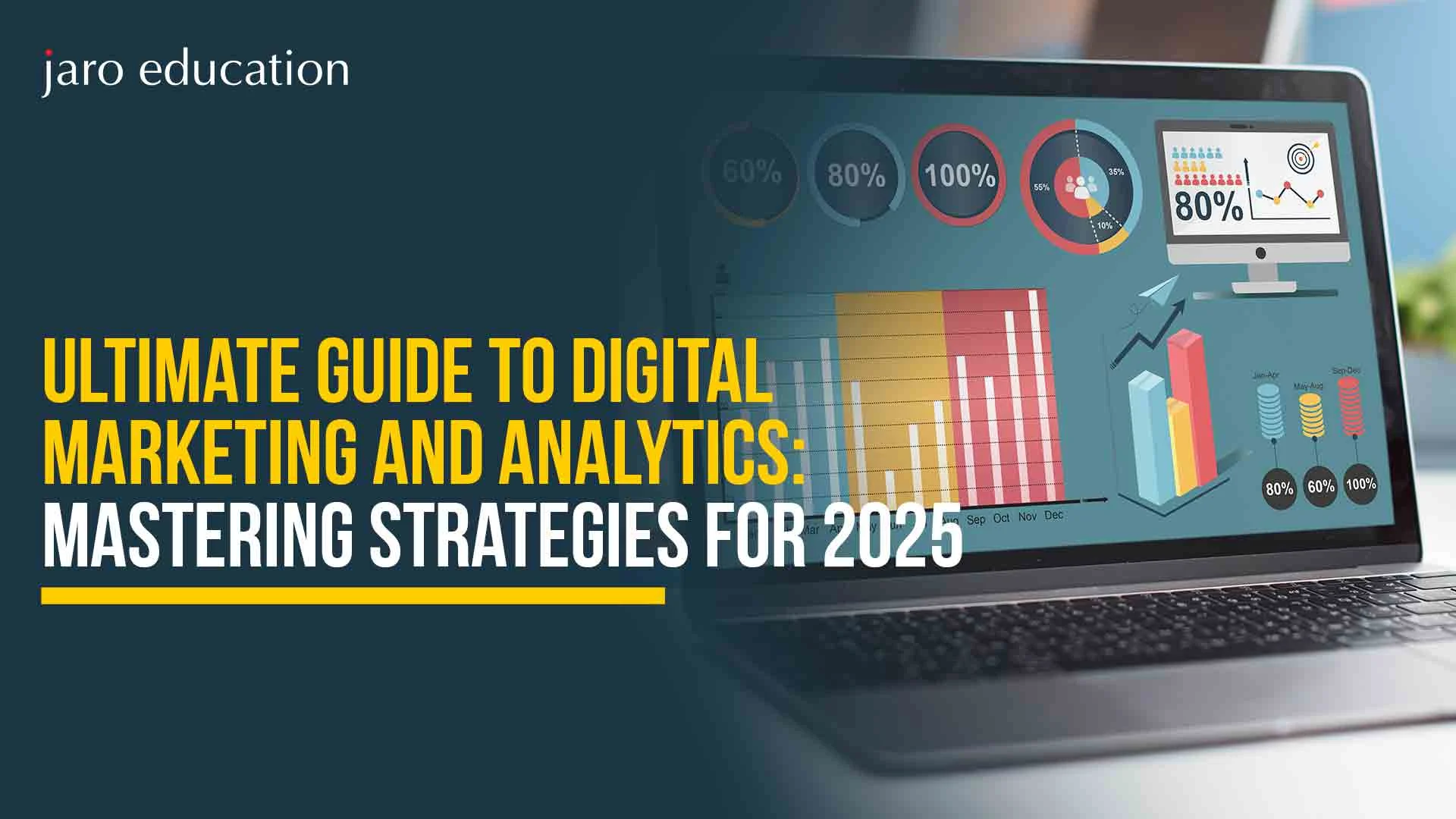Ultimate Guide to Digital Marketing and Analytics: Mastering Strategies for 2025
Table of Contents

Gone are the days when marketing a product or service was a hassle. The advent of digital technologies has transformed the way companies function and market their products. Digital marketing and analytics tools and strategies have become the cornerstone of business success, enabling brands to reach the right audience, optimize performance, and drive measurable growth.
Therefore, in 2025, learning these tools and strategies to gauge the performance of each digital marketing campaign has become essential. This write-up aims to illuminate the critical tools, common hurdles of digital marketing campaigns, and tips for overcoming these challenges to help you elevate your marketing game.

*freepik.com
Importance of Analytics in Digital Marketing
Digital marketing, as the term suggests, is the process of marketing brands online. Some of the popular methods used here are search engine optimization (SEO), email marketing, social media marketing, etc. On the other hand, analytics is all about studying customers’ reactions towards it and making the right changes to achieve the desired results.
So, here are some reasons why analytics is an integral part of digital marketing –
- Tracks performance: Analytics provide data on how many people visited a website, read a promotional email, or clicked on advertisements. Seeing this information, digital marketers can readily take action.
- Understands customers: Analytics can provide data that reveals customers’ age, location, and interests. Businesses, in turn, can communicate directly with the right person through messaging.
- Improves campaigns: With the data collected from analytics, marketers can make changes to their campaigns. For example, they can change an image or a message and try.
- Measures return on investment (ROI): With the data from analytics, companies can measure how much they are spending and how much they are earning.
- Saves money: Analytics can show which advertisements are not working. Based on this data, businesses can stop spending on useless campaigns and invest in methods that work better.
Digital marketing and analytics are inseparable now, especially for companies that want to stay in the long run.
Some Important Digital Marketing Analytics Tools in 2025
What if someone embarked on a sea voyage without knowing the route? Which tool can help the most in such a situation? Of course, a compass. The digital marketing and analytics tools serve the purpose of these compasses. They guide the businesses on the right track by providing the necessary data to perform well. In 2025, many of these tools will have become essential to run a successful marketing campaign. Details of some such tools are mentioned here.
- Google Analytics 4 (GA4):
Google Analytics 4 is a free web analytics service hosted by Google. It can tell how people interact with a website or mobile app.
Pros:
- Its basic version is free.
- It gives marketers more control.
- It has enhanced device tracking capabilities.
- It has the ability to perform cross-platform tracking.
- It gives businesses a deeper understanding of their app and website visitor behaviors.
Cons:
- It has a limit to data collection.
- It provides no customer support.
- It has a different interface that does not match with its previous version.
- It limits the migration of historical data from its previous version.
- It is not fully compliant with the General Data Protection Regulation (GDPR).
- Adobe Analytics:
Adobe Analytics is part of Adobe Experience Cloud, a powerful web analytics platform that companies often choose for its customizability and in-depth reporting.
Pros:
- It provides a user-friendly interface.
- It provides a rich set of tools.
- It has an easy-to-build conversion funnel.
- It provides options to set alerts for a given threshold.
- It supports other Adobe marketing tools, making the work easier.
Cons:
- It is more expensive than many other tools.
- It is less suitable for small and medium-sized businesses due to its high cost.
- It has no solid technical support.
- It is not an easy analytic tool to use.
- It is not easy to set up Adobe Analytics and may require technical expertise.
- HubSpot Analytics:
HubSpot analytics helps measure the performance of all the marketing campaigns that are running at once. It particularly helps the inbound marketing process.
Pros:
- It has a user-friendly interface.
- It is highly scalable and supports the needs of both small startups and midsize businesses.
- It provides an understandable view of website traffic sources, helping businesses analyze organic traffic, social media traffic, direct traffic, etc.
- It assures total security to its users.
- It empowers businesses to fully understand their customers.
Cons:
- It becomes costly when all its functions are used.
- It may not offer the same depth of analysis for specific needs.
- It works well when used with other HubSpot tools, which may not be feasible for businesses that are only looking for analytics.
- It has a poor selection of email formats.
- It has annual contracts that one cannot opt out of.
- SEMrush:
SEMrush is an all-in-one platform that mainly helps with search engine optimization (SEO). It not only performs competitive analysis but also provides a deep understanding of overall digital marketing performance.
Pros:
- It provides a useful keyword research tool to identify popular search items.
- It helps to analyze the gap between a keyword and the backlink.
- It offers a user-friendly PPC tool that guides at every step of a campaign.
- It helps spot which keywords are not working for a business compared to the competitors.
- It provides tools that help businesses to gauge the strategies of their competitors.
Cons:
- It is quite expensive, especially for small businesses or individuals.
- Its subscription plans mostly include one use, which does not work for teams.
- Its keyword data is meant for only Google, not for other search engines.
- It provides a rough estimate of the traffic data, which is not always accurate.
- Its user interface may be difficult to navigate for many.
Digital Marketing Strategies and Analytics
Every process has some flaws. Digital marketing is also not an exception. Thanks to analytics tools! They help detect these loopholes early. Immediately, businesses will take up smart strategies to fix them. Digital marketing and analytics are indeed a wonderful combination! Here are some common problems faced by digital marketers and how they solve those with the help of analytics.
1. Low Website Traffic
This problem occurs mainly when fewer visitors come to a website than others. It affects the company’s online visibility and, in turn, its growth. There may be various reasons for this, like not following proper SEO practices, poor content, dull website design, etc.
Some tools, like Google Analytics, can detect this low traffic by adding a small tracking code on the website. It tracks the number, regularity, and source of visitors. If there is a sudden drop in the number, they send alerts. They also track which pages are getting less attention.
Companies immediately focus on the low-performing pages and improve them by changing content, design, etc. Using better keywords can even solve SEO issues. Switching to paid ads is a good practice to improve visibility.
2. High Bounce Rate
At times, many people visit a company’s website but leave immediately without going to another page. They do not even click on any link. This means they have not found what they were looking for on that website, which largely affects a business’s success.
Analytics collects total ‘ bounce rate ‘ data with the help of a tracking code. They can say which pages have high bounce rates and also the below-average time certain visitors spend on the site.
Knowing this data, companies can develop strategies to make those pages more attractive and easier to use. They can add clear buttons and useful content and speed up the website.
3. Low Conversion Rate
Everyone who visits a website does not sign up or buy products. Only a few visitors do this. This means that most people do not do what the companies want after seeing the content. This is called a low conversion rate.
Analytics tracks the actions of the users visiting a website or an ad. It also compares the total number of people visiting the website to those who are actually signing up or buying. If the number is very low, the tool reports a low conversion rate.
Immediately, the companies take action to fix the problem. They can make the site easier to use and faster to load, use strong and clear messages to guide users, test different versions of pages or ads to see what works best, offer discounts or free shipping, etc.
4. Poor Social Media Engagement
Poor social media engagement is a serious issue. People visit the company pages on different social media platforms but don’t engage with the posts by liking, commenting, and sharing them. This means the audience is not finding the content interesting. So, very few people are actually getting involved with the brand online.
Analytics can easily track an ad’s or website’s likes, shares, comments, and clicks. If these numbers are lower than the number of visitors, the tool indicates that the level of engagement is not meeting expectations.
To fix this problem ASAP, companies can post more interesting and useful content, attractive images or videos, post at the right time, ask questions, respond to comments, use hashtags, etc. They can also take help from influencers to reach more people.
5. Unsuccessful AD Campaigns
There are advertisements that do not get the desired number of clicks, sales, or sign-ups. This may be because they have reached the wrong audience, used poor designs, or sent weak messages. As a result, the money is wasted, as these ads bring little or no return.
Analytics can track clicks, views, sales, and other ad campaign results. When they see that many people have viewed the ad, but very few have bought or signed up, they become sure that the ad campaign is not working. Even though the cost is high, the low results mean the ad is unsuccessful.
To fix this problem, companies can change their ad text or images, target a better audience, try different platforms, etc. They can also A/B test different ad versions to see what works best. However, they must adjust their budgets and focus on ads that bring better results.

*freepik.com
Conclusion
Today, marketing is not only about being online. A business needs to be customer-focused. Now, in 2025, there are multiple new technologies, tools, and trends. Only businesses that can combine creative digital marketing and analytics will survive. Who knows, they may also become the leaders in the days to come. Therefore, knowing how to use suitable tools and making decisions based on real data can make every campaign successful. Nowadays, every part of digital marketing needs the power of analytics. It helps the brands reach the right audience at the right time and convey the right message. So, no more guessing. Start tracking!
However, it is not possible to gain expertise in using these tools overnight. Undergoing certain courses can be helpful. However, most working professionals cannot attend classes on stipulated time slots. So, a short-duration online course like the Professional Certificate Programme in Digital Marketing for Performance & Growth – IIM Kozhikode can be the best choice. IIM Kozhikode is offering this course in collaboration with Jaro Education, India’s premier online education provider. Besides access to such excellent courses, Jaro Education also focuses on grooming students for their next step in life. They offer student support and guidance through counseling to ensure they find the right career path.
Frequently Asked Questions
What is new in digital marketing today?
Today, marketers rely more on ethical tracking. Also, with the discovery of AI tools, the process of running campaigns and doing research for content creation has become smooth.
Is there any need for digital marketing and analytics tools to run small businesses?
Yes. Such tools can definitely help small businesses to grow faster. Certain tools offer free or low-cost services to track customer behavior and optimize campaigns accordingly. By using these, small businesses can make smarter marketing decisions.
Can a person without any background in data learn digital marketing and analytics?
Yes. Today, there are many modern tools that do not require coding or technical skills. These tools are also user-friendly. Some examples are Google Analytics, HubSpot, etc. There are free courses or tutorials through which one can learn the basics. Confidence will come with time and experience.
Why is data so important in digital marketing and analytics?
It has been a proven fact for ages that businesses run on data. It helps the marketers to know which strategy works and which does not. So, with this information, they can focus on campaigns that are bringing good results. In fact, they can work on making those perform even better.


















